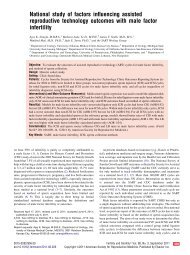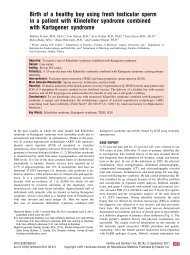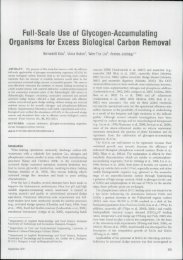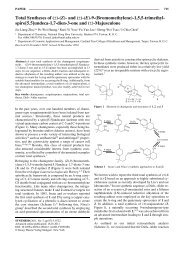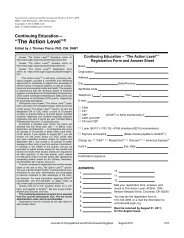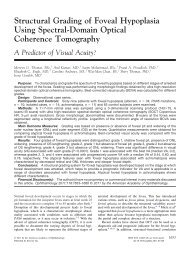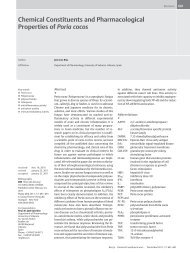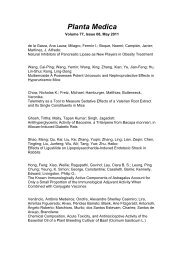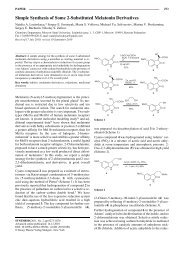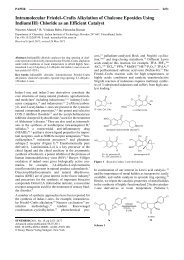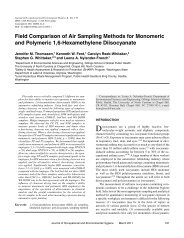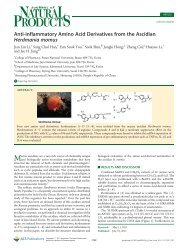Thionations Using a P4S10-Pyridine Complex in Solvents Such as ...
Thionations Using a P4S10-Pyridine Complex in Solvents Such as ...
Thionations Using a P4S10-Pyridine Complex in Solvents Such as ...
Create successful ePaper yourself
Turn your PDF publications into a flip-book with our unique Google optimized e-Paper software.
<strong>Thionations</strong> <strong>Us<strong>in</strong>g</strong> a P 4S 10-<strong>Pyrid<strong>in</strong>e</strong> <strong>Complex</strong> <strong>in</strong> <strong>Solvents</strong><br />
<strong>Such</strong> <strong>as</strong> Acetonitrile and Dimethyl Sulfone<br />
Jan Bergman,* ,† Birgitta Pettersson, † Vedran H<strong>as</strong>imbegovic, † and Per H. Svensson ‡,§<br />
† Unit of Organic Chemistry, Department of Biosciences at Novum, Karol<strong>in</strong>ska Institute, SE-141 57 Hudd<strong>in</strong>ge, Sweden<br />
‡ Pharmaceutical Development, Astra Zeneca R&D, S€odert€alje, S-151 85 S€odert€alje, Sweden<br />
bS Support<strong>in</strong>g Information<br />
Received: September 27, 2010<br />
Published: February 22, 2011<br />
ARTICLE<br />
pubs.acs.org/joc<br />
ABSTRACT: Tetraphosphorus dec<strong>as</strong>ulfide (<strong>P4S10</strong>) <strong>in</strong> pyrid<strong>in</strong>e h<strong>as</strong><br />
been used <strong>as</strong> a thionat<strong>in</strong>g agent for a long period of time. The<br />
moisture-sensitive reagent h<strong>as</strong> now been isolated <strong>in</strong> crystall<strong>in</strong>e form,<br />
and the detailed structure h<strong>as</strong> been determ<strong>in</strong>ed by X-ray crystallography.<br />
The thionat<strong>in</strong>g power of this storable reagent h<strong>as</strong> been<br />
studied and transferred to solvents such <strong>as</strong> acetonitrile <strong>in</strong> which it h<strong>as</strong><br />
proven to be synthetically useful and exceptionally selective. Its<br />
properties have been compared with the so-called Lawesson reagent<br />
(LR). Particularly <strong>in</strong>terest<strong>in</strong>g are the results from thionations at relatively high temperatures (∼165 °C) <strong>in</strong> dimethyl sulfone <strong>as</strong><br />
solvent. Under these conditions, for <strong>in</strong>stance, acridone and 3-acetyl<strong>in</strong>dole could quickly be transformed to the correspond<strong>in</strong>g<br />
thionated derivatives. Glycylglyc<strong>in</strong>e similarly gave piperaz<strong>in</strong>edithione. At these temperatures, LR is <strong>in</strong>efficient due to rapid<br />
decomposition. The thionated products are generally cleaner and more e<strong>as</strong>y to obta<strong>in</strong> because <strong>in</strong> the crystall<strong>in</strong>e reagent, impurities<br />
which <strong>in</strong>variably are present <strong>in</strong> the conventional reagents, <strong>P4S10</strong> <strong>in</strong> pyrid<strong>in</strong>e or LR, have been removed.<br />
’ INTRODUCTION<br />
In spite of the fact that the comb<strong>in</strong>ation of <strong>P4S10</strong> 1 and<br />
pyrid<strong>in</strong>e, <strong>as</strong> a successful reagent for thionation of amides and<br />
several other cl<strong>as</strong>ses of molecules w<strong>as</strong> <strong>in</strong>troduced by Kl<strong>in</strong>gsberg 1<br />
<strong>as</strong> early <strong>as</strong> <strong>in</strong> 1951, the so-called Lawesson’s reagent (2a, LR) h<strong>as</strong><br />
been much more commonly used for this purpose (Figure 1). 2-8<br />
Actually, the reagent 2a w<strong>as</strong> <strong>in</strong>troduced <strong>in</strong> 1968 for transformations<br />
<strong>in</strong> organic chemistry by Schumacher, 2 who utilized it with a<br />
considerable number of reactants, such <strong>as</strong> benzophenone, triphenylphosph<strong>in</strong>e<br />
oxide, and camphor, which were thionated <strong>in</strong><br />
fair yields, but also <strong>in</strong>teractions with more unexpected reactants<br />
like azirid<strong>in</strong>e and phenylacetylene were studied. Unfortunately,<br />
Schumacher’s sem<strong>in</strong>al work h<strong>as</strong> only partially been considered<br />
<strong>in</strong> the reviews deal<strong>in</strong>g with 2a by Cava, 4 Jesberger, 5 Wooll<strong>in</strong>s, 9<br />
Kaushik, 10 and Ozturk 6 et al.<br />
<strong>Pyrid<strong>in</strong>e</strong> and <strong>P4S10</strong> react readily to form the zwitterionic,<br />
nonsmell<strong>in</strong>g reagent (3), whose composition, P2S5 3 2C5H5N, w<strong>as</strong> studied <strong>as</strong> early <strong>as</strong> 1967-1968 by German <strong>in</strong>organic chemists<br />
8,11 who obta<strong>in</strong>ed evidence for structure 3 by 31 PNMRdata 12<br />
<strong>as</strong> well <strong>as</strong> by comparison with related molecules. In spite of that,<br />
We<strong>in</strong>traub 13 and S€oder, 13,14 obviously without knowledge of the<br />
previous work, much later <strong>in</strong>troduced structure 4 for the product<br />
obta<strong>in</strong>ed from <strong>P4S10</strong> and pyrid<strong>in</strong>e. This composition, <strong>P4S10</strong> 3<br />
4C5H5N, h<strong>as</strong> been reta<strong>in</strong>ed even <strong>in</strong> relatively recent work. 15<br />
A large number of other methods to modify <strong>P4S10</strong> are known,<br />
such <strong>as</strong> addition of NaHCO3 or Na2CO3, R-Li, and (TMS)2O<br />
and, <strong>as</strong> recently demonstrated, even silicon oil. 16-23 Some of these<br />
procedures are difficult to reproduce. 24<br />
We became <strong>in</strong>trigued by the overwhelm<strong>in</strong>g bi<strong>as</strong> <strong>in</strong> favor of 2a<br />
over 3 when we found that <strong>in</strong>digo 5 (Figure 2) reacted efficiently<br />
Figure 1. Graphical representation of molecular structures 1-4.<br />
with 3 to give 6 <strong>in</strong> reflux<strong>in</strong>g pyrid<strong>in</strong>e, where<strong>as</strong> 2a w<strong>as</strong> totally<br />
<strong>in</strong>efficient <strong>in</strong> this solvent. 25 It should be noted though that 2a<br />
and related reagents (e.g., 2b) will react with pyrid<strong>in</strong>e to give,<br />
e.g., 8. 26,27 At an early ph<strong>as</strong>e <strong>in</strong> this project, it w<strong>as</strong> noted that the<br />
reagent 3 h<strong>as</strong> a much higher thermal stability than 2a. It h<strong>as</strong> even<br />
been reported that 2a will start to decompose above 110 °C, 5,6<br />
r 2011 American Chemical Society 1546 dx.doi.org/10.1021/jo101865y | J. Org. Chem. 2011, 76, 1546–1553
The Journal of Organic Chemistry ARTICLE<br />
Figure 2. Graphical representation of molecular structures 5-17.<br />
where<strong>as</strong> the zwitterionic molecule 3 can be successfully used for<br />
thionations <strong>as</strong> a melt or, even better, dissolved <strong>in</strong> dimethylsulfone,<br />
<strong>in</strong> the range 165-175 °C (vide <strong>in</strong>fra).<br />
There are further drawbacks with the reagent 2a; thus it h<strong>as</strong><br />
been reported that acridone 9a can be converted to the correspond<strong>in</strong>g<br />
thionated molecule 9b by <strong>P4S10</strong> <strong>in</strong> HMPA, where<strong>as</strong> the<br />
reagent 2a failed. 28 It h<strong>as</strong> now been found that 9a is readily (1 h at<br />
reflux) thionated by 3 <strong>in</strong> acetonitrile or with<strong>in</strong> m<strong>in</strong>utes <strong>in</strong> hot<br />
dimethyl sulfone. Additional drawbacks with the reagent 2a are<br />
its low solubility, the coformation of foul-smell<strong>in</strong>g side products<br />
that are difficult to separate from the desired molecules 28-30<br />
(column chromatography is often required), and that HMPA (a<br />
solvent that is prohibited <strong>in</strong> Sweden and many other countries)<br />
quite often h<strong>as</strong> to be used. The low solubility of 2a h<strong>as</strong> <strong>in</strong>duced<br />
workers to <strong>in</strong>troduce various variants such <strong>as</strong> fluorous LR<br />
reagents 31 and LR reagents carry<strong>in</strong>g additional substituents. 21<br />
The low solubility h<strong>as</strong> <strong>in</strong>duced several research groups to use LR<br />
<strong>in</strong> comb<strong>in</strong>ation with microwaves. 32,33 In this f<strong>as</strong>hion, γ-lactones<br />
can be converted to γ-thiolactones, for example. 32 Actually,<br />
the drawbacks <strong>as</strong>sociated with 2a have prompted Ley et al. to<br />
develop a polymer-supported thionat<strong>in</strong>g reagent prepared from<br />
a diam<strong>in</strong>e res<strong>in</strong> and ethyl dichlorothiophosphate. 29 F<strong>in</strong>ally, it<br />
should be stressed that <strong>in</strong> none of the thionations described<br />
here<strong>in</strong> chromatographic purification w<strong>as</strong> necessary.<br />
’ RESULTS AND DISCUSSION<br />
With this background, we decided to study <strong>in</strong> more detail the<br />
efficiency of 3 <strong>as</strong> a thionat<strong>in</strong>g agent with special emph<strong>as</strong>is on the<br />
utilization of the reagent <strong>in</strong> “neutral” solvents such <strong>as</strong> acetonitrile<br />
for the preparation of thioamides, a cl<strong>as</strong>s of compounds that are<br />
of importance <strong>as</strong> they can be readily converted to several types<br />
of heterocycles 30 and also coupled with arylboronic acids under<br />
Pd catalysis. 34-37 Thus, e.g., pyrid<strong>in</strong>e-2(1H)-thione will undergo<br />
carbon-carbon cross-coupl<strong>in</strong>g with phenylboronic acid <strong>in</strong> high<br />
yield to give 2-phenylpyrid<strong>in</strong>e. 34-37 Similarly, 2-thiouracil h<strong>as</strong><br />
been coupled with, e.g., 2-furyltributylstannane to 2-furyl-2pyrimid<strong>in</strong>-4-one.<br />
38<br />
As two structures have been suggested for the <strong>P4S10</strong>-pyrid<strong>in</strong>e<br />
reagent we have also performed an X-ray study, which gave<br />
conclusive evidence for structure 3. A somewhat related structure,<br />
namely 10, h<strong>as</strong> been determ<strong>in</strong>ed by Meisel et al. (Figure 2). 39 This<br />
ionic complex seems not to have been used for thionation purposes.<br />
This is also true for the hybrides 7 and 8.<br />
The zwitterionic reagent 3 h<strong>as</strong> fair solubility <strong>in</strong> hot acetonitrile<br />
and a good solubility <strong>in</strong> hot pyrid<strong>in</strong>e. Addition of water to a hot<br />
solution/suspension of 3 <strong>in</strong> acetonitrile will quickly result <strong>in</strong> a<br />
clear solution. Actually, the reagent quickly undergoes extensive<br />
degradation <strong>in</strong> the presence of water; big, beautiful crystals of the<br />
salt 11a could be isolated and the detailed structure determ<strong>in</strong>ed<br />
by X-ray crystallography. The salt 11a is readily soluble <strong>in</strong> water<br />
and had previously been prepared and studied by reaction of the<br />
fluor<strong>in</strong>e-conta<strong>in</strong><strong>in</strong>g zwitterionic pyrid<strong>in</strong>ium salt 12 (Figure 2)<br />
with ethyldiphenylphosph<strong>in</strong>e. 40,41 The ready formation and high<br />
solubility of the salt 11a can be advantageously used dur<strong>in</strong>g<br />
workup of, e.g., thioamides. Thus, <strong>in</strong> a typical experiment, 4 equiv<br />
of an amide w<strong>as</strong> heated with 1.1 equiv of the reagent 3 <strong>in</strong> dry<br />
acetonitrile, and <strong>in</strong> connection with the workup any rema<strong>in</strong><strong>in</strong>g<br />
reagent w<strong>as</strong> readily removed by addition of water. The reagent 3<br />
will also decompose when treated with alcohols. Thus, ethanol<br />
gave the salt 11b. The structure of 11b w<strong>as</strong> proven by neutraliz<strong>in</strong>g<br />
the strong (pKa = 1.62) 42 acid 11c with pyrid<strong>in</strong>e, which<br />
gave an identical product (Figure 2). The acid 11c w<strong>as</strong> readily<br />
prepared by dissolution of P 4S 10 <strong>in</strong> ethanol. The reagent 2a (LR)<br />
is also sensitive to water, <strong>as</strong> noted already <strong>in</strong> 1956 by Lecher et al.<br />
who found that after a period of reflux (18 h) <strong>in</strong> water, the reagent<br />
w<strong>as</strong> completely converted to p-anisylphosphoric acid 13a. 43 The<br />
same molecule had <strong>in</strong> 2002 also been synthesized by Aragoni<br />
et al. by first heat<strong>in</strong>g 2a together with an excess of methyl iodide<br />
at reflux for 5 h. 44 This methylated <strong>in</strong>termediate thus obta<strong>in</strong>ed,<br />
w<strong>as</strong> then stored for two weeks <strong>in</strong> open atmosphere which gave<br />
p-anisylphosphoric acid 13a suitable for X-ray studies. The same<br />
molecule 13a h<strong>as</strong> now been obta<strong>in</strong>ed quite quickly after a period<br />
of reflux (5 m<strong>in</strong>) of 2a <strong>in</strong> acetonitrile conta<strong>in</strong><strong>in</strong>g a few percent of<br />
water. The partially hydrolyzed molecule 13b, which can readily<br />
undergo cyclocondensation, w<strong>as</strong> never observed. 45 It thus appears<br />
that the reagent 2a is much more sensitive to water than<br />
previously believed. The quick hydrolysis observed <strong>in</strong> this<br />
medium can be perceived by <strong>as</strong>sum<strong>in</strong>g that dedimerization <strong>in</strong><br />
acetonitrile to the reactive species 14 is particularly favorable <strong>in</strong><br />
this medium with its high dielectric constant. Actually, there is<br />
evidence 42,46-50 that the reagent 2a dissociates to the reactive<br />
species 14 <strong>in</strong> a rate-determ<strong>in</strong><strong>in</strong>g step dur<strong>in</strong>g the thionation<br />
process. It is at present not clear if the reagent 3 thionates <strong>as</strong><br />
such or via dissociation to species such <strong>as</strong> 15 or 16. Formation of<br />
16 h<strong>as</strong> previously been formulated <strong>as</strong> part of the dissociation of<br />
P 4S 10. 6<br />
1547 dx.doi.org/10.1021/jo101865y |J. Org. Chem. 2011, 76, 1546–1553
The Journal of Organic Chemistry ARTICLE<br />
Figure 3. (a) Molecular and (b) crystal structure of 3. The crystal<br />
structure conta<strong>in</strong>s two symmetry <strong>in</strong>dependent molecules (a).<br />
Figure 4. (a) Molecular and (b) crystal structure of 11a.<br />
The crystal structure of the reagent 2a h<strong>as</strong> been determ<strong>in</strong>ed by<br />
Grossman, 51 and now the structure of 3 h<strong>as</strong> been confirmed by<br />
X-ray analysis, the details of which are given <strong>in</strong> the Experimental<br />
Section, and an ORTEP representation of the molecular structure<br />
is shown <strong>in</strong> Figure 3. The molecules are l<strong>in</strong>ked together<br />
via several van der Waal <strong>in</strong>teractions. The strongest van der<br />
Waal contact (C-H 333 S) l<strong>in</strong>ks the molecules together <strong>in</strong>to and<br />
<strong>in</strong>f<strong>in</strong>ite cha<strong>in</strong> along the c-axis. The pack<strong>in</strong>g coefficient (percent<br />
filled van der Waals space <strong>in</strong> the unit-cell) is 67.7%, <strong>in</strong>dicat<strong>in</strong>g an<br />
efficient molecular framework <strong>in</strong> the solid state. The molecular<br />
pack<strong>in</strong>g is facilitated by the aromatic π stack<strong>in</strong>g. The distance<br />
between the planes of two adjacent aromatic moieties is approximately<br />
3.5 Å.<br />
Very recently, a related structure, namely 17 (Figure 2), h<strong>as</strong><br />
been determ<strong>in</strong>ed us<strong>in</strong>g X-ray crystallography. 52 This molecule<br />
w<strong>as</strong> prepared by heat<strong>in</strong>g P 4S 10 <strong>in</strong> pyrid<strong>in</strong>e together with S 8.<br />
The capacity of 17 to act <strong>as</strong> a thionat<strong>in</strong>g agent is so far unknown.<br />
The structure of 11a w<strong>as</strong> confirmed by X-ray analysis, the<br />
details of which are given <strong>in</strong> the Experimental Section, and<br />
an ORTEP representation of the molecular structure is shown <strong>in</strong><br />
Figure 4.<br />
The outcome of a number of thionation experiments with<br />
the zwitterionic reagent 3 <strong>in</strong> hot acetonitrile are listed <strong>in</strong> Table 1.<br />
The ratio to reactant w<strong>as</strong> always 1.1:4. In other words, it is<br />
<strong>as</strong>sumed that the central sulfur atom is devoid of thionat<strong>in</strong>g<br />
power. In some c<strong>as</strong>es, direct comparisons with 2a have been<br />
made. For <strong>in</strong>stance, ε-caprolactam and 3 gave the correspond<strong>in</strong>g<br />
thioamide with<strong>in</strong> 5 m<strong>in</strong>, but 2a thionates even f<strong>as</strong>ter. Actually, a<br />
suspension of 2a <strong>in</strong> hot acetonitrile can be titrated by addition of<br />
ε-caprolactam. The advantage of 3 over 2a is primarily that 3 is<br />
e<strong>as</strong>ier to prepare, odorless (when sufficiently pure) and that the<br />
Table 1. <strong>Thionations</strong> of Amides with the Reagent 3 <strong>in</strong> Hot<br />
MeCN<br />
a Isolated product conta<strong>in</strong>ed two rotamers (<strong>in</strong> agreement with previous<br />
reports 64,65 ). b HRMS (EIþ) m/z calcd for C 12H 11NS: 201.0612, found<br />
201.0621.<br />
1548 dx.doi.org/10.1021/jo101865y |J. Org. Chem. 2011, 76, 1546–1553
The Journal of Organic Chemistry ARTICLE<br />
thionated products are very pure. Formation of nitriles from<br />
primary amides never w<strong>as</strong> a problem. This type of side reaction<br />
can sometimes be problematic when the reagent 2a is used. 27,29<br />
Thionation of ketones with 3 worked well provided that electrondonat<strong>in</strong>g<br />
groups are present <strong>as</strong> <strong>in</strong> 18a and 18b (Table 2, entries 3<br />
and 4). The keto derivatives 20a and 21a could be converted to<br />
20b and 21b, respectively, when the reagent 3 is used <strong>in</strong> hot<br />
pyrid<strong>in</strong>e or <strong>as</strong> a melt or even better, when heated together with<br />
dimethyl sulfone (Table 1, entry 20, and Table 3, entry 3).<br />
Where<strong>as</strong> thionation of 3,3-dimethylox<strong>in</strong>dole (entry 7, Table 1)<br />
gave an excellent yield, the parent compound, ox<strong>in</strong>dole (entry 6,<br />
Table 1) gave unacceptably low yields (∼10%). Here, formation<br />
of complexes of low solubility seems to be the cause of<br />
the problems. For synthesis of this molecule, <strong>in</strong>dol<strong>in</strong>e-2-thione,<br />
the method by Pedr<strong>as</strong> (P 4S 10 þ NaHCO 3 <strong>in</strong> THF) is recommended.<br />
53 Synthesis of 3,3-di<strong>in</strong>dolyl<strong>in</strong>dol<strong>in</strong>e-2-thione also failed<br />
but could be effected with dimethyl sulfone <strong>as</strong> solvent (see<br />
Table 3). Thionation of 3-hydroxy-2-pyridone worked well without<br />
complications to give the <strong>in</strong>terest<strong>in</strong>g cl<strong>as</strong>s of 3-hydroxy-<br />
2-(1H)-pyrid<strong>in</strong>ethione, which for several types of metal complexes<br />
(e.g., Zn 2þ ) have shown some promise aga<strong>in</strong>st diabetes mellitus. 54<br />
Forceful conditions, namely treatment of 3-hydroxy-2-pyridone<br />
with <strong>P4S10</strong> at 200 °C had previously been used for synthesis of this<br />
cl<strong>as</strong>s of compounds. 55<br />
Thionation of 3-hydroxy-2-qu<strong>in</strong>olone similarly gave the known<br />
thione (Table 2, entry 6) which previously had been synthesized<br />
by a different technique.<br />
In c<strong>as</strong>es where more than one carbonyl group is present <strong>in</strong><br />
the start<strong>in</strong>g materials, selectivity could be achieved. Thus, the<br />
monothionated molecules (Table 1, entries 12, 16, and 17) could<br />
be obta<strong>in</strong>ed <strong>in</strong> good yields. Thionation of piperid<strong>in</strong>e-2,6-dione<br />
gave the monothionated product <strong>in</strong> hot acetonitrile, where<strong>as</strong><br />
with an excess of the reagent <strong>in</strong> hot pyrid<strong>in</strong>e the fully thionated<br />
product could be obta<strong>in</strong>ed. These two molecules had previously<br />
been synthesized and characterized a long time ago by Berg and<br />
Sandstr€om. 56<br />
Thionation of Gly-Gly <strong>as</strong> well <strong>as</strong> piperaz<strong>in</strong>e-2,5-dione both<br />
gave good yields of the expected dithionated product (Table 2,<br />
entries 1 and 2). To further characterize the rather <strong>in</strong>soluble<br />
product, it w<strong>as</strong> acetylated <strong>in</strong> hot acetic anhydride, which yielded<br />
the tetraacetylated product 35 (Figure 7), which readily gave nice<br />
NMR spectra.<br />
<strong>Thionations</strong> at quite high temperatures (165-175 °C) could<br />
be affected with suitable reactants and the reagent 3 dissolved <strong>in</strong><br />
dimethyl sulfone (mp 107-109 °C, bp 238 °C). The results are<br />
listed <strong>in</strong> Table 3. In one c<strong>as</strong>e (Table 3, entry 6) the product w<strong>as</strong><br />
partially converted to the highly <strong>in</strong>soluble disulfide 22. Similar<br />
observations have been reported by Stoyanov 78,79 and H<strong>in</strong>o<br />
et al. 80 The latter workers found that a number of 3-substituted<br />
<strong>in</strong>dole-2-thiones readily could be oxidized to the correspond<strong>in</strong>g<br />
disulfides. Formation of oxidative products could be avoided by<br />
runn<strong>in</strong>g the reactions under argon. Thionation of ox<strong>in</strong>dole h<strong>as</strong><br />
also been studied under these high temperature conditions, at<br />
first, without air protection. The product obta<strong>in</strong>ed w<strong>as</strong> high<br />
melt<strong>in</strong>g and had the composition C16H10N2S2, a clear <strong>in</strong>dication<br />
that oxidative coupl<strong>in</strong>gs had occurred. This product w<strong>as</strong><br />
tentatively <strong>as</strong>signed either structure 23 or structure 24<br />
(Figure 5).<br />
The alternative 24 could soon be ruled out because reductive<br />
cleavage of two S-S bonds with sodium borohydride <strong>in</strong> THF<br />
of the known molecule 25 25,81 (an X-ray structure is available 25 )<br />
gave the dianion 26 (Figure 5), which when exposed to air slowly<br />
Table 2. <strong>Thionations</strong> with the Reagent 3 <strong>in</strong> Hot <strong>Pyrid<strong>in</strong>e</strong><br />
a Obta<strong>in</strong>ed from DMF-H2O. b The spectral data were identical with the<br />
product from entry 1.<br />
gave the pentacyclic molecule 23, which proved to be identical<br />
with the product C10H10N2S2 discussed above. On the other<br />
hand, acidification of the dianion 26 immediately gave the<br />
correspond<strong>in</strong>g acid which existed exclusively <strong>as</strong> the thione<br />
tautomer 27. The diagnostic aliphatic hydrogen atoms resonated<br />
at 60.8 ppm <strong>in</strong> the 13 C NMR spectrum. Quench<strong>in</strong>g of the dianion<br />
with dimethyl sulfate gave, <strong>as</strong> expected, 2,2 0 -bis-methylthiolo-<br />
3,3 0 -bi<strong>in</strong>dolyl, a known molecule. 81<br />
The alleged reductive transformation (25 f 23) had previously<br />
been described by Carpenter et al., 81 but it seems likely<br />
that the product isolated at the time w<strong>as</strong> the dithione 27 and<br />
not the claimed pentacycle 23. The bisthione 27 h<strong>as</strong> now been<br />
characterized for the first time. In contr<strong>as</strong>t, its N,N-dimethyl<br />
derivative h<strong>as</strong>, due to work by H<strong>in</strong>o et al., been known s<strong>in</strong>ce<br />
1969. 82 The structure of this derivative h<strong>as</strong> also been confirmed<br />
by X-ray crystallography. 83 It should also be added<br />
that compound 23 is much more stable than its previously<br />
studied isomer 28, which h<strong>as</strong> a strong tendency to undergo<br />
dimerization. 84<br />
Benzaldehyde h<strong>as</strong> been thionated many times <strong>in</strong> the p<strong>as</strong>t, 85-90<br />
and the product h<strong>as</strong> <strong>in</strong>variably been isolated <strong>as</strong> the trimer (30)of<br />
the unstable primary product 29 (Figure 6), and the trimer 30,<br />
w<strong>as</strong> <strong>in</strong>deed the product when benzaldehyde w<strong>as</strong> reacted with the<br />
reagent 3 <strong>in</strong> dimethyl sulfone.<br />
Ester carbonyl groups are generally not attacked by the reagent<br />
3 <strong>as</strong> can be exemplified by thionation (Table 3, entry 10)<br />
of the monoacetate of kojic acid (31), which selectively gave<br />
the thione 32 (Table 1, entry 17). Thionation of the diester<br />
33a, obta<strong>in</strong>ed by addition of methyl β-am<strong>in</strong>ocrotonate to maleic<br />
anhydride followed by esterification with methanol accord<strong>in</strong>g to<br />
1549 dx.doi.org/10.1021/jo101865y |J. Org. Chem. 2011, 76, 1546–1553
The Journal of Organic Chemistry ARTICLE<br />
Table 3. <strong>Thionations</strong> <strong>in</strong> Dimethyl Sulfone with 3 at 165-175 °C<br />
a Experiment run under argon.<br />
a literature procedure, 91 offered an other example, namely the<br />
pyrrole-2-thiol derivative 34b (Figure 7).<br />
The start<strong>in</strong>g material existed completely (NMR evidence) <strong>as</strong> the<br />
tautomer 33a, where<strong>as</strong> the product existed completely <strong>as</strong> the thiol<br />
Figure 5. Graphical representation of molecular structures 22-28.<br />
Figure 6. Structures of benzothialdehyde (29) and its correspond<strong>in</strong>g<br />
trimer (30).<br />
Figure 7. Structures of monoacetate of kojic acid (31), its thionated<br />
derivative (32), and structures 33-35.<br />
tautomer 34b. But, more importantly, the two ester functions were<br />
<strong>in</strong>tact. These results, are <strong>in</strong> nice agreement with general predictions<br />
about the tautomeric situation, given by Elguero. 92 Due to low<br />
solubility and high melt<strong>in</strong>g po<strong>in</strong>t, 2,5-piperaz<strong>in</strong>edithione (Table 3,<br />
entry 12) w<strong>as</strong> difficult to characterize; therefore, the readily soluble<br />
tetraacetate 35 w<strong>as</strong> prepared.<br />
’ CONCLUSIONS<br />
The structure of the reagent obta<strong>in</strong>ed by reaction of <strong>P4S10</strong><br />
with pyrid<strong>in</strong>e h<strong>as</strong> been determ<strong>in</strong>ed. This crystall<strong>in</strong>e and storable<br />
1550 dx.doi.org/10.1021/jo101865y |J. Org. Chem. 2011, 76, 1546–1553
The Journal of Organic Chemistry ARTICLE<br />
reagent is free from impurities <strong>in</strong>herent <strong>in</strong> the conventional<br />
reagent because these impurities (from P 4S 10) are removed via<br />
the pyrid<strong>in</strong>e mother liquor.<br />
The improved purity will result <strong>in</strong> cleaner thionation products<br />
and more facile workup procedures. A particular advantage is the<br />
fact that the reagent can be transferred to other solvents such <strong>as</strong><br />
acetonitrile and dimethyl sulfone.<br />
’ EXPERIMENTAL SECTION<br />
Reagent 3. Tetraphosphorus dec<strong>as</strong>ulfide (<strong>P4S10</strong>, 44.5 g, 0.1 mol)<br />
w<strong>as</strong> added <strong>in</strong> portions to dry pyrid<strong>in</strong>e (560 mL) at 80 °C us<strong>in</strong>g stirr<strong>in</strong>g<br />
equipment. After a period of reflux (1 h), a clear yellow solution<br />
w<strong>as</strong> obta<strong>in</strong>ed, which deposited light-yellow crystals when the solution<br />
w<strong>as</strong> allowed to cool. After 2 h the crystals were collected, w<strong>as</strong>hed with<br />
dry acetonitrile and f<strong>in</strong>ally transferred to an exicator (conta<strong>in</strong><strong>in</strong>g a beaker<br />
with concd sulfuric acid) to remove any excess of pyrid<strong>in</strong>e: yield 62.3 g<br />
(84%); mp 167-169 °C; IR νmax 3088, 3040, 1608, 1451, 1197, 1044,<br />
723, 668 cm -1 .<br />
Pyrid<strong>in</strong>ium Dihydrogen Monothiophosphate, 11a. The<br />
reagent 3 (3.80 g, 10 mmol) w<strong>as</strong> heated at reflux temperature <strong>in</strong><br />
acetonitrile (35 mL) conta<strong>in</strong><strong>in</strong>g water (1.0 mL). The clear solution<br />
(obta<strong>in</strong>ed with<strong>in</strong> 3 m<strong>in</strong>) w<strong>as</strong> concentrated and the product allowed<br />
to crystallize, 3.15 g, (79%). The crystals were suitable for X-ray<br />
crystallography: mp 110-120 °C dec, with evolution of H 2S; 1 HNMR<br />
(300 MHz, DMSO-d6) δ 7.51 (m, 2H, 3-H), 7.95 (dd, 1H, 4-H), 8.63<br />
(d, 2H, 2-H), 9.7 (br s, 3H); 13 C NMR (75.5 MHz, DMSO-d6) δ 124.7<br />
(d), 138.5 (d), 147.8 (d).<br />
Pyrid<strong>in</strong>ium O,O-Diethyldithiophosphonate 11b from 3. The<br />
reagent 3 (1.0 g) w<strong>as</strong> heated at reflux <strong>in</strong> ethanol (5 mL) for 5 m<strong>in</strong>, and the<br />
clear solution w<strong>as</strong> evaporated to give an oil which soon solidified (100%):<br />
IR ν max 2976, 2891, 1630, 1600, 1526, 1479, 1383, 1020, 920, 748, 681 cm -1 ;<br />
1 H NMR (300 MHz, DMSO-d6) δ 1.08 (t, J = 7.1 Hz, 6H), 3.79 (m, 4H),<br />
8.09 (m, 2H), 8.62 (m, 1H), 8.97 (m, 2H); 13 C NMR (75.5 MHz, DMSOd<br />
6) δ 16.1 (q, 3 J C-P = 8.8 Hz), 59.8 (t, 2 J C-P = 7.1 Hz), 127.2 (d), 142.5<br />
(d), 146.0 (d). The salt 11b couldalsoe<strong>as</strong>ilybepreparedbyneutraliz<strong>in</strong>gthe<br />
known acid 38 11c with pyrid<strong>in</strong>e.<br />
<strong>Thionations</strong> with 3 <strong>in</strong> Dimethyl Sulfone, General Procedure.<br />
The reactant (10 mmol) and the reagent 3 (3 mmol) plus dimethyl sulfone<br />
(5.0 g) were heated at 170-175 °C for 15 m<strong>in</strong>. The solidified melt w<strong>as</strong><br />
added to boil<strong>in</strong>g water. After 10-15 m<strong>in</strong>, the separated product w<strong>as</strong><br />
collected and recrystallized if necessary.<br />
<strong>Thionations</strong> with 3 <strong>in</strong> Acetonitrile, General Procedure.<br />
The reactant (40 mmol) and the reagent 3 (12 mmol) were heated at<br />
reflux temperature <strong>in</strong> acetonitrile (40 mL). A clear solution w<strong>as</strong> usually<br />
quickly formed which with<strong>in</strong> 15 m<strong>in</strong> became turbid. After a period of<br />
reflux (30 m<strong>in</strong>), the two-ph<strong>as</strong>e system w<strong>as</strong> concentrated to ca. 20 mL,<br />
and water (30 mL) w<strong>as</strong> added. A solid w<strong>as</strong> quickly formed which w<strong>as</strong><br />
filtered, w<strong>as</strong>hed with water, and recrystallized if necessary to give pure<br />
product.<br />
(S)-11-Thioxo-2,3,11,11a-tetrahydro-1H-benzo[e]pyrrolo-<br />
[1,2-a][1,4]diazep<strong>in</strong>-5-(10H)-one (Table 1, Entry 17). To a<br />
MeCN solution (200 mL) of 2,3-dihydro-1H-benzo[e]pyrrolo[1,2-a]-<br />
[1,4]diazep<strong>in</strong>e-5,11(10H,11aH)-dione (4.3 g, 20 mmol) w<strong>as</strong> added the<br />
reagent 3 (2.3 g, 6 mmol) and the mixture heated to 60 °C for 3 h dur<strong>in</strong>g<br />
which time a yellow precipitate w<strong>as</strong> formed. The reaction mixture w<strong>as</strong><br />
allowed to stand at room temperature overnight <strong>in</strong> order to precipitate<br />
fully. The product w<strong>as</strong> vacuum-filtered and w<strong>as</strong>hed with a little cold<br />
MeCN to give the title compound (3.9 g, 85%) <strong>as</strong> a pale yellow solid: mp<br />
268-270 °C (lit. 70 mp 253-254 °C); [R] 23 D þ971 (c 0.16, MeOH)<br />
[lit. 70 [R] 23 D þ873 (c 1.026, DMSO)]; IR νmax 3170, 2979, 1616, 1602,<br />
1477, 1374, 1271, 1141, 831, 813, 752 cm -1 ; 1 H NMR (300 MHz,<br />
DMSO-d 6) δ 1.89-1.94 (m, 1H), 1.99-2.16 (m, 2H), 2.84-2.94 (m,<br />
1H), 3.40-3.50 (m, 1H), 3.53-3.60 (m, 1H), 4.27 (d, J = 6.11 Hz, 1H),<br />
7.22-7.27 (m, 1H), 7.30-7.37 (m, 1H), 7.55-7.60 (m, 1H), 7.80-<br />
7.85 (m, 1H), 12.46 (br s, 1H); 13 C NMR (75.5 MHz, DMSO-d 6)<br />
δ 22.7(t), 29.0 (t), 46.8 (t), 59.8 (d), 121.8 (d), 125.7 (d), 127.8 (s),<br />
130.2 (d), 132.2 (d),136.5 (s),164.2 (s), 201.9 (s).<br />
Spiro[cyclopentane-1,2 0 (1 0 H)-qu<strong>in</strong>azol<strong>in</strong>e]-4 0 (3 0 H)-thione<br />
(Table 1, Entry 18). Reagent (0.96 g, 25 mmol) 3 w<strong>as</strong> added to a<br />
suspension of spiro[cyclopentane-1,2 0 (1 0 H)-qu<strong>in</strong>azol<strong>in</strong>]-4 0 (3 0 H)-one<br />
(1.0 g, 5 mmol) <strong>in</strong> acetonitrile (50 mL), and the reaction mixture w<strong>as</strong><br />
heated at reflux for 7 h. After be<strong>in</strong>g cooled to room temperature, the<br />
dark-red solution w<strong>as</strong> poured <strong>in</strong>to water and allowed to stand <strong>in</strong> the<br />
refrigerator overnight. The precipitate w<strong>as</strong> collected and w<strong>as</strong>hed with a<br />
small amount of cold MeCN to give the title compound (0.97 g, 89%) <strong>as</strong><br />
orange flakes: mp 226 °C; IR ν max 3389, 3254, 3128, 2966, 1612, 1531,<br />
1468, 1235, 1148, 994, 748 cm -1 ; 1 H NMR (300 MHz, DMSO-d6)<br />
δ ppm 1.65-1.69 (m, 4H), 1.76-1.80 (m, 2H), 1.88-1.95 (m, 2H),<br />
6.65-6.71 (2H, m), 7.08 (s, 1H), 7.24 (t, J = 7.6 Hz, 1H), 8.04 (d, J = 7.9<br />
Hz, 1H), 10.29 (s, 1H); 13 C NMR (75.5 MHz, DMSO-d6) δ ppm 22.2<br />
(t), 38.5 (t), 77.1 (s), 114.8 (d), 116.9 (d), 119.4 (s), 131.4 (d), 133.7<br />
(d), 143.6 (s), 188.5 (s). Anal. Calcd for C12H14N2S: C, 66.02; H, 6.46;<br />
N, 12.83. Found: C, 65.92; H, 6.11; N, 12.53.<br />
2,5-Piperaz<strong>in</strong>edithione from Glyc<strong>in</strong>e (Table 2, Entry 1).<br />
Glyc<strong>in</strong>e (1.50 g, 20 mmol), the reagent 3 (10.64 g, 28 mmol), and<br />
dimethyl sulfone (8.0 g) were heated at 165-170 °C for 1 h, whereupon<br />
the reaction mixture (after cool<strong>in</strong>g) w<strong>as</strong> treated with boil<strong>in</strong>g water for<br />
30 m<strong>in</strong>. The brownish solid obta<strong>in</strong>ed w<strong>as</strong> recrystallized from ethanol/<br />
DMF, 1.85 g (63%): mp 284 °C (lit. 71 mp 285 °C); 1 H NMR (300 MHz,<br />
DMSO-d 6) δ 4.19 (s), 10.7 (s) [lit. 71 4.22, 7.23 ppm (we consider that<br />
this reported signal for the -NH protons is <strong>in</strong> error)]; 13 C NMR (75.5<br />
MHz, DMSO-d6) δ 54.4 (q), 191.9 (s) [lit. 71 54.1, 193.7].<br />
2,5-Piperaz<strong>in</strong>edithione from 2,5-Piperaz<strong>in</strong>edione (Table 2,<br />
Entry 2). 2,5-Piperaz<strong>in</strong>edione (2.28 g, 20 mmol) and the reagent 3<br />
(2.28 g, 8 mmol) were heated at reflux <strong>in</strong> acetonitrile (50 mL) for 2 h,<br />
when the mixture w<strong>as</strong> concentrated and water w<strong>as</strong> added. The solid<br />
formed w<strong>as</strong> collected after a stirr<strong>in</strong>g period of 1 h, 2.63 g (90%).<br />
Melt<strong>in</strong>g po<strong>in</strong>t and NMR data are identical to data reported above for<br />
2,5-piperaz<strong>in</strong>edithione from glyc<strong>in</strong>e (Table 2, entry 1).<br />
S,S 0 -1,4-Diacetyl-2,5-bis-acetylthiolo-1,4-dihydropyraz<strong>in</strong>e,<br />
35. The above 2,5-piperaz<strong>in</strong>edithione (1.46 g, 10 mmol) w<strong>as</strong> heated at<br />
reflux temperature <strong>in</strong> acetic anhydride (20 mL) for 2 h, whereupon the<br />
reaction mixture w<strong>as</strong> concentrated and treated with diisopropyl ether,<br />
2.92 g (93%): mp 190-192 °C; 1 H NMR (300 MHz, DMSO-d 6) δ 2.17<br />
(s, 6H), 2.45 (s, 6H), 6.99 (s, 2H); 13 C NMR (75.5 MHz, DMSO-d6) δ<br />
22.2 (q), 29.4 (q), 117.0 (s), 131.6 (d), 166.3 (s), 193.7 (s). Anal. Calcd<br />
for C12H14N2O4S2: C, 45.75; H, 4.48; N, 8.88. Found: C, 45.90; H, 4.32;<br />
N, 8.71.<br />
Reductive Cleavage of the Tetr<strong>as</strong>ulfide, 25. The 3,3 0 -di<strong>in</strong>dolyl-2,2<br />
0 -tetr<strong>as</strong>ulfide 25 (3.58 g, 10 mmol) w<strong>as</strong> dissolved <strong>in</strong> THF<br />
(50 mL) and added to a mixture of NaBH 4 (1.50 g, 40 mmol) <strong>in</strong> THF<br />
(75 mL). Evolution of g<strong>as</strong>es conta<strong>in</strong><strong>in</strong>g H2S ensued, and the reaction<br />
mixture w<strong>as</strong> stirred for 3 h at 40-45 °C under a blanket of argon. This<br />
air-sensitive solution conta<strong>in</strong><strong>in</strong>g the dianion 26 w<strong>as</strong> not stored but<br />
directly transformed by operations described below.<br />
2,2 0 -Bis(methylthio)-1H,1 0 H-3,3 0 -bi<strong>in</strong>dole. Dimethyl sulfate<br />
(1.51 g, 10 mmol) dissolved <strong>in</strong> MeOH (15 mL) w<strong>as</strong> added dropwise<br />
to a solution obta<strong>in</strong>ed by reductive cleavage of the tetr<strong>as</strong>ulfide 25<br />
(5 mmol) at 25 °C. After a period (1 h) of stirr<strong>in</strong>g, the solution w<strong>as</strong><br />
evaporated and treated with water. The crude solid w<strong>as</strong> crystallized from<br />
MeOH-water to yield a yellow solid (0.92 g, 57%): mp 184-186 °C<br />
(lit. 81 mp 187-188 °C); 1 H NMR (300 MHz, DMSO-d 6) δ 2.07 (s,<br />
6H), 7.04-7.08 (m, 2H), 7.28-7.33 (m, 4H), 7.49-7.51 (m, 2H),<br />
12.16 (s, 2H); 13 C NMR (75.5 MHz, DMSO-d6) δ 18.0 (q), 110.8 (s),<br />
110.9 (d), 119.0 (d), 119.2 (d), 121.5 (d), 128.0 (s), 129.1 (s), 137.0 (s).<br />
Synthesis of the Cyclodisulfide, 23. A solution obta<strong>in</strong>ed<br />
by reductive cleavage of the tetr<strong>as</strong>ulfide 25 w<strong>as</strong>, after addition of water<br />
1551 dx.doi.org/10.1021/jo101865y |J. Org. Chem. 2011, 76, 1546–1553
The Journal of Organic Chemistry ARTICLE<br />
(50 mL), stirred for 24 h <strong>in</strong> contact with air. The yellow solid formed w<strong>as</strong><br />
collected and crystallized from acetonitrile-DMF 4:1 yield<strong>in</strong>g 2.20 g<br />
(77%) of a solid still conta<strong>in</strong><strong>in</strong>g DMF, which w<strong>as</strong> removed by dry<strong>in</strong>g<br />
under reduced pressure: mp >227-228 °C (lit. 81 mp 206-208 °C); 1 H<br />
NMR (300 MHz, DMSO-d 6) δ 7.04-7.08 (m, 1H), 7.28-7.31 (m,<br />
2H), 7.33-7.51 (m, 1H), 12.16 (s, 1H); 13 C NMR (75.5 MHz, DMSOd6)<br />
δ 136.3 (s), 127.0 (s), 124.9 (s), 124.6 (d), 120.3 (d), 120.2 (d),<br />
119.3 (s), 112.2 (d).<br />
Cyclodisulfide 23 by Thionation of Ox<strong>in</strong>dole at 160 °C<br />
(Table 3, Entry 13). Ox<strong>in</strong>dole (1.33 g, 10 mmol) and the reagent 3<br />
(1.52 g, 4 mmol) were warmed with dimethyl sulfone (4. 0 g) and then<br />
heated at 160 °C for 5 m<strong>in</strong>. The melt w<strong>as</strong> allowed to cool and then<br />
heated with water. The solid formed w<strong>as</strong> crystallized from acetonitrile-<br />
DMF 4:1 yield<strong>in</strong>g 1.37 g (92%): mp >227-228 °C. This material w<strong>as</strong><br />
identical with that obta<strong>in</strong>ed via reductive cleavage of the tetr<strong>as</strong>ulfide 25.<br />
3,3 0 -Bithio-ox<strong>in</strong>dole, 27. The solution obta<strong>in</strong>ed from reductive<br />
cleavage of the tetr<strong>as</strong>ulfide 25 w<strong>as</strong> acidified with AcOH, which resulted<br />
<strong>in</strong> quick formation of the title compound <strong>as</strong> a yellow precipitate, 2.52 g<br />
(85%). The precipitate w<strong>as</strong> recrystallized from acetonitrile, mp 180 °C<br />
dec. This molecule is sensitive toward aerial oxidation: 1 H NMR (300<br />
MHz, DMSO-d6) δ 4.66 (s, 2H), 6.85-6.91 (m, 4H), 6.96-6.98 (m,<br />
2H), 7.07-7.13 (m, 2H), 13.06 (s, 2H); 13 C NMR (75.5 MHz, DMSOd6)<br />
δ 60.8 (d), 110.4 (d), 123.0 (d), 123.4 (d), 128.6 (d), 130.2 (s),<br />
144.2 (s), 204.3 (s). Anal. Calcd for C 16 H 12N 2S 2: C, 64.60; H, 4.08; N,<br />
9.43. Found: C, 64.26; H, 3.99; N, 9.31.<br />
Methyl 5-Mercapto-4-(2-methoxy-2-oxoethyl)-2-methyl-<br />
1H-pyrrole-3-carboxylate, 34b. The diester 33a (2.13 g, 10 mmol)<br />
and the reagent 3 (1.14 g, 4 mmol) were heated at reflux temperature <strong>in</strong><br />
acetonitrile (50 mL) for 1 h. After concentration to 25 mL, water w<strong>as</strong><br />
added and the solid formed collected and crystallized from 2-propanol,<br />
1.85 g (81%): mp 185-187 °C; IR ν max 3273, 2954, 1742, 1724, 1707,<br />
1681, 1562, 1440, 1341, 1269, 1200, 1173, 1117, 1080, 1003, 782 cm -1 ;<br />
1 H NMR (300 MHz, DMSO-d6) δ 2.43 (s, 3H), 3.17 (s, 2H), 3.38 (s,<br />
1H), 3.49 (s, 3H), 3.64 (s, 3H), 11.90 (s 1H); 13 C NMR (75.5 MHz,<br />
DMSO-d6) δ 13.4 (q), 30.6 (d), 50.4 (q), 51.4 (q), 111.2 (s), 117.1 (s),<br />
126.9 (s), 139.9 (s), 164.4 (s), 171.1 (s)Anal. Calcd for C 10 H 13NO 4S: C,<br />
49.37; H, 5.38; N 5.75. Found: C, 49.25; H, 5.46; N, 5.61.<br />
3-(1H-Indol-3-yl)-3,3 0 -bi<strong>in</strong>dol<strong>in</strong>e-2-thione (Table 3, Entry 9).<br />
3-(1H-Indol-3-yl)-3,3 0 -bi<strong>in</strong>dol<strong>in</strong>-2-one 105 (728 mg, 2 mmol), the reagent 3<br />
(228 mg, 0.6 mmol), and dimethyl sulfone (3.05 g) were heated (165-<br />
170 °C) for 20 m<strong>in</strong>. The melt w<strong>as</strong> allowed to cool and then heated <strong>in</strong> water<br />
for 10 m<strong>in</strong>. The solid formed w<strong>as</strong> collected, 713 mg (94%): mp >260 °C;<br />
1 H NMR (300 MHz, DMSO-d6) δ 7.09-7.15 (m, 2H), 7.18-7.20 (m,<br />
5H), 7.24-7.30 (m, 7H), 13.00 (s, 1H); 13 C NMR (75.5 MHz, DMSO-d 6)<br />
δ 72.7 (s), 111.2 (d), 124.4 (d), 126.5 (d), 127.5 (d), 128.6 (d), 128.7 (d),<br />
129.0 (d), 129.1 (d), 129.1 (d), 139.2 (s), 143.0 (s), 143.5 (s), 145.3 (s,<br />
2C), 208.4 (s). Anal. Calcd for C24H17N3S: C, 75.96; H, 4.51; N, 11.07.<br />
Found: C, 76.10; H, 4.46; N, 11.00.<br />
’ ASSOCIATED CONTENT<br />
bS Support<strong>in</strong>g Information. The crystal structural data of 3<br />
and 11a have been deposited at Cambridge Data Centre and<br />
allocated the deposition numbers CCDC 789665 and CCDC<br />
789666. CIFs for compounds 3 and 11a are <strong>in</strong>cluded. Experimental<br />
details for 6H-<strong>in</strong>dolo[2,3-b]qu<strong>in</strong>ol<strong>in</strong>-11-one and compounds<br />
13a and 33a (Table 1, entries 2, 3, and 8). Compound<br />
characterization data for 6H-<strong>in</strong>dolo[2,3-b]qu<strong>in</strong>ol<strong>in</strong>-11-one and<br />
compounds 13a and 33a (Table 1, entries 2, 3, 8, and 11; Table 3,<br />
entries 3, 7, and 10). Copies of 1 H and 13 C NMR spectra for all<br />
new compounds. Copies of 1 H NMR are provided for most<br />
compounds <strong>in</strong> the tables. This material is available free of charge<br />
via the Internet at http://pubs.acs.org.<br />
’ AUTHOR INFORMATION<br />
Correspond<strong>in</strong>g Author<br />
*E-mail: jan.bergman@ki.se.<br />
Present Addresses<br />
§ School of Chemical Science and Eng<strong>in</strong>eer<strong>in</strong>g, Royal Institute of<br />
Technology, Teknikr<strong>in</strong>gen 30, 100 44 Stockholm, Sweden.<br />
’ REFERENCES<br />
(1) Kl<strong>in</strong>gsberg, E.; Papa, D. J. Am. Chem. Soc. 1951, 73, 4988–4989.<br />
(2) (a) Schumacher, G. Ph.D. Thesis, University of Ma<strong>in</strong>z, Germany,<br />
1968. (b) Hoffman, H.; Schumacher, G. Tetrahedron Lett. 1967, 31,<br />
2963–2966.<br />
(3) Scheibye, S. Ph.D. Thesis, University of Aarhus, Denmark, 1981.<br />
(4) Cava, M. P.; Lev<strong>in</strong>son, M. I. Tetrahedron 1985, 41, 5061–5087.<br />
(5) Jesberger, M.; Davis, T. P.; Berner, L. Synthesis 2003, 1929–<br />
1958.<br />
(6) (a) Ozturk, T.; Erdal, E.; Olcay, M. Chem. Rev. 2007, 107, 5210–<br />
5278 and references cited there<strong>in</strong>. (b) Ozturk, T.; Erdal, E.; Olcay, M.<br />
Chem. Rev. 2010, 110, 3419–3478 and references cited there<strong>in</strong>.<br />
(7) Shaumann, E. Compr. Org. Synth. I 1991, 6, 419–434.<br />
(8) Meisel, M.; Grunze, H. Z. Anorg. Allg. Chem. 1967, 360, 277–283.<br />
(9) Foreman, M. St. J.; Wooll<strong>in</strong>s, J. D. J. Chem. Soc., Dalton Trans.<br />
2000, 1533–1543.<br />
(10) Polshettiwar, V.; Kaushik, M. P. J. Sulfur Chem. 2006, 27, 353–<br />
386.<br />
(11) Fluck, E.; B<strong>in</strong>der, H. Z. Anorg. Allg. Chem. 1967, 354, 113–129.<br />
(12) Brunel, E.; Monzur, J.; Retuert, J. J. Chem. Res., M<strong>in</strong>ipr<strong>in</strong>t 1981,<br />
3437–3445.<br />
(13) We<strong>in</strong>traub, P. M. Int. J. Sulfur Chem. 1973, 8, 321–327.<br />
(14) S€oder, A. Ger. Pat. 2,822,113, 1979.<br />
(15) Stratman, J. Pharm. Acta Helv. 1989, 64, 252–255.<br />
(16) Brillon, D. Sulfur Rep. 1992, 12, 297–338.<br />
(17) Goel, O. P.; Krolls, U. Synthesis 1987, 162–164.<br />
(18) Charette, A. D.; Grenon, M. J. Org. Chem. 2003, 68, 5792.<br />
(19) Scheeren, J. W.; Ooms, P. H. J.; Nivard, R. J. F. Synthesis 1973,<br />
149–151.<br />
(20) Curphey, T. J. Org. Chem. 2002, 67, 6461–6473.<br />
(21) Foreman, M. S. J.; Slaw<strong>in</strong>, A. M. Z.; Wooll<strong>in</strong>s, J. D. Heteroatom<br />
Chem. 1999, 10, 651–657.<br />
(22) Lapucha, A. R. Synthesis 1987, 256–258.<br />
(23) Cho, D.; Ahn, J.; C<strong>as</strong>tro, K. A. D.; Ahn, H.; Rhee, H. Tetrahedron<br />
2010, 66, 5583–5588.<br />
(24) Kaneko, K.; Katayama, H.; Wakabay<strong>as</strong>hi, T.; Kumonoka, T.<br />
Synthesis 1988, 152–158.<br />
(25) Janosik, T.; Bergman, J.; Stensland, B.; Stalhandske, C. J. Chem.<br />
Soc., Perk<strong>in</strong> Trans. 1 2002, 330–334.<br />
(26) Fluck, E.; B<strong>in</strong>der, H. Angew. Chem. 1966, 78, 666.<br />
(27) Scheibye, S.; Shabana, R.; Lawesson, S. O.; R€omm<strong>in</strong>g, C.<br />
Tetrahedron 1982, 38, 993–1001.<br />
(28) Smolders, R. R.; Hanuise, J.; Coomans, R.; Proietto, V.; Voglet,<br />
N.; Waefelaer, A. Synthesis 1982, 493–494.<br />
(29) Ley, S. V.; Leach, A. G.; Storer, R. I. J. Chem. Soc., Perk<strong>in</strong> Trans. 1<br />
2001, 358–361.<br />
(30) Jagodz<strong>in</strong>ski, T. S. Chem. Rev. 2003, 103, 197–227.<br />
(31) Kaleta, Z.; Tarkanyi, G.; A, G.; Kalman, F.; Nagy, T.; Soos, T.<br />
Org. Lett. 2006, 8, 1093–1095.<br />
(32) Filippi, J. J.; Fernandez, X.; Lizzani-Cuvelier, L.; Loiseau, A. M.<br />
Tetrahedron Lett. 2003, 44, 6647–6650.<br />
(33) Seij<strong>as</strong>, J. A.; Vazquez-Tato, M. P.; Martínez, M. M.; Rodríguez-<br />
Parga, J. Green Chem. 2002, 4, 390–391.<br />
(34) Prokopcova, H.; Kappe, O. C. Adv. Syn. Catal. 2007, 349, 448–<br />
452.<br />
(35) Kappe, O. C.; Prokopcova, H. Angew. Chem. 2009, 48,2276–2286.<br />
(36) Nuzhat, A.; Jamshed, H.; Kappe, O. C. J. Org. Chem. 2009, 74,<br />
5118–5121.<br />
1552 dx.doi.org/10.1021/jo101865y |J. Org. Chem. 2011, 76, 1546–1553
The Journal of Organic Chemistry ARTICLE<br />
(37) Prokopcova, H.; Kappe, O. C. J. Org. Chem. 2007, 72, 4440–<br />
4448.<br />
(38) Sun, Q.; Suzenet, F.; Guillaume, G. J. Org. Chem. 2010, 75,<br />
3473–3476.<br />
(39) Meisel, M.; L€onnecke, P.; Grimmer, A. R.; Wulff-Molder, D.<br />
Angew. Chem., Int. Ed. 1997, 36, 1869–1870.<br />
(40) Ziemer, B.; Rabis, A. Acta Crystallogr. 2000, C41, e94.<br />
(41) Fluck, E.; Retuert, P. J. Z. Anorg. Allg. Chem. 1973, 225–<br />
236.<br />
(42) Oae, S.; Nakanishi, A.; Tsujimoto, N. Tetrahedron 1972, 28,<br />
2981–2990.<br />
(43) Lecher, H. Z.; Greenwood, R. A.; Whitehouse, K. C.; Chao.,<br />
T. H. J. Am. Chem. Soc. 1956, 78, 5018–5022.<br />
(44) Aragoni, M. C.; Arca, M.; Blake, J. A.; Lippolis, V.; Schroeder,<br />
M.; Wilson, C. Acta Crystallogr. C 2002, C58, o260–o262.<br />
(45) Przychodzen, W. Eur. J. Org. Chem. 2005, 2002–2014 and<br />
references cited there<strong>in</strong>.<br />
(46) Rauchfuss, T. B.; Zank, G. A. Tetrahedron Lett. 1986, 27, 3445–<br />
3448.<br />
(47) Ohida, H.; Ishii, A.; Nakayama, J. Tetrahedron Lett. 2004, 45,<br />
1331–1334.<br />
(48) Perregaard, J.; Thomsen, I.; Lawesson, S. O. Bull. Soc. Chim.<br />
Belg. 1977, 86, 321.<br />
(49) Perregaard, J. Ph.D. Thesis, University of Aarhus, Denmark<br />
1977.<br />
(50) Dubau-Assibat, N.; Baceiredo, A.; Bertrand, G. J. Org. Chem.<br />
1995, 60, 3904–3906.<br />
(51) Grossman, G.; Ohms, G.; Kr€uger, K.; Jeschke, G.; Jones, P. G.;<br />
Fischer, A. Phosphorus, Sulfur Silicon 1995, 107, 57–68.<br />
(52) Rotter, C.; Evangelisti, C.; Sch€onberger, S.; Klap€otke, T. M.;<br />
Karaghiosoff, K.Chem. Commun. 2010, 46, 5024–5025.<br />
(53) Pedr<strong>as</strong>, M.; Soledade, C.; Jha, M. J. Org. Chem. 2005, 70, 1828–<br />
1834.<br />
(54) Katoh, A.; Yokoyama, H.; Matsumura, Y.; Yoshikawa, Y.; Y<strong>as</strong>ui,<br />
H.; Sakurai, H. Heterocycles 2010, 81, 585–600.<br />
(55) Davies, J. S.; Smith, K.; Turner, J. Tetrahedron Lett. 1980, 21,<br />
2191–2194.<br />
(56) Berg, U.; Sandstr€om, J. Acta Chem. Scand. 1966, 698–697.<br />
(57) Rae, I. D. Aust. J. Chem. 1979, 32, 567–573.<br />
(58) Black, D. S. C.; Watson, K. G. Aust. J. Chem. 1973, 26, 2177–<br />
2182.<br />
(59) Benner, S. A. Tetrahedron Lett. 1981, 22, 1851–1854.<br />
(60) Moody, C. J.; Slaw<strong>in</strong>, A. M. Z.; Willows, D. Org. Biomol. Chem.<br />
2003, 1, 2716–2722.<br />
(61) Goswami, S.; Maity, A. C.; D<strong>as</strong>, N. K. J. Sulfur Chem. 2007, 28,<br />
233–237.<br />
(62) Wang, C.-H.; Hwang, F.-Y.; Horng, J.-M.; Chen, C.-T. Heterocycles<br />
1979, 12, 1191–1198.<br />
(63) Perregaard, J.; Lawesson, S. O. Acta Chem. Scand. 1975, 29,<br />
604–608.<br />
(64) Nagarajan, K.; Nair, M. D. Tetrahedron 1967, 23, 4493–4497.<br />
(65) Nagarajan, K.; Nair, M. D.; Pillai, P. M. Tetrahedron 1967, 23,<br />
1683–1690.<br />
(66) Thirtle, J. R. J. Am. Chem. Soc. 1946, 68, 342–343.<br />
(67) Still, I. W. J.; Plavac, N.; McK<strong>in</strong>non, D. M.; Chauhan, M. S. Can.<br />
J. Chem. 1976, 54, 280–289.<br />
(68) Katritzky, A. R.; Grzeskowiak, N. E. J. Chem. Res., Synop. 1981,<br />
7, 208–209.<br />
(69) Undheim, K.; Nordal, V.; Tjønneland, K. Acta Chem. Scand.<br />
1969, 23, 1704.<br />
(70) Rekowski, M. v. W.; Pyriochou, A.; Papapetropoulos, N.;<br />
Stossel, A.; Papapetropoulos, A.; Giannis, A. Bioorg. Med. Chem. 2010,<br />
18, 1288–1296.<br />
(71) Hartke, K.; Brutsche, A. Arch. Pharm. 1993, 326, 63–65.<br />
(72) Kuipers, J. A. M.; Lammer<strong>in</strong>k, B. H. M.; Still, I. W. J.;<br />
Zwanenburg, B. Synthesis 1981, 295–297.<br />
(73) Olszewska, T.; Gdaniec, M.; Polonski, T. J. Org. Chem. 2004,<br />
1248–1255.<br />
(74) Greibrokk, T.; Undheim, K. Acta Chem. Scand. 1971, 25, 2935–<br />
2942.<br />
(75) Morrison, D. C.; Furst, A. J. Org. Chem. 1956, 21, 470–471.<br />
(76) Volosh<strong>in</strong>, Y. Z.; Belov, A. S.; Lebedev, A. Y.; Varzatskii, O. A.;<br />
Antip<strong>in</strong>, M. Y.; Starikova, Z. A.; Kron, T. E. Russ. Chem. Bull. 2004,<br />
1218–1222.<br />
(77) Mphahlele, M. J.; El-Nah<strong>as</strong>, A. M.; El-Gogary, T. M. J. Mol.<br />
Struct. 2004, 690, 151–157.<br />
(78) Stoyanov, S.; Petkov, I.; Antonov, L.; Stoyanova, T.; Karagiannidis,<br />
P.; Aslanidis, P. Can. J. Chem. 1990, 68, 1482–1489.<br />
(79) Stoyanov, S.; Stoyanova, T.; Antonov, L.; Karagiannidis, P.;<br />
Akrivos, P. Monatsh. Chem. 1996, 495–504.<br />
(80) H<strong>in</strong>o, T.; Suzuki, T.; Nakagawa, M. Chem. Pharm. Bull 1974,<br />
22, 1053–1060.<br />
(81) Carpenter, W.; Grant, M. S.; Snyder, H. R. J. Am. Chem. Soc.<br />
1960, 82, 2739–2742.<br />
(82) H<strong>in</strong>o, T.; Tsuneoka, K.; Nakagawa, M.; Akaboshi, S. Chem.<br />
Pharm. Bull. 1969, 17, 550–558.<br />
(83) Baumeister, U.; Hartung, H.; Spitzner, R.; Felicetti, M.;<br />
Schroth, W. Acta Crystallogr. 2000, C56, 830–831.<br />
(84) Janosik, T.; Bergman, J.; Romero, I.; Stensland, B.; Stalhandske,<br />
C.; Marques, M. M. B.; Santos, M. M. M.; Lobo, A. M.; Prabhakar,<br />
S.; Duarte, M. F.; Florencio, M. H. Eur. J. Org. Chem. 2002, 1392–<br />
1396.<br />
(85) Baumann, E.; From, E. Ber. 1889, 22, 2600–2609.<br />
(86) Stanfield, J. A.; Reynolds, L. B. J. Am. Chem. Soc. 1952, 74,<br />
2878–2880.<br />
(87) B€ottcher, B.; Bauer, F. Liebigs Ann. Chem. 1951, 574, 218–226.<br />
(88) Takikawa, Y.; Shimoda, K.; Makabe, T.; Takizawa, S. Chem.<br />
Lett. 1983, 1503–1506.<br />
(89) Sekido, K.; Hirokawa, S. Acta Crystallogr. 1985, C41, 379–400.<br />
(90) Bon<strong>in</strong>i, B. F.; Mazzanti, G.; Zani, P.; Maccagani, G.; Foresti, E.<br />
J. Chem. Soc., Perk<strong>in</strong> Trans 1 1988, 1499–1502.<br />
(91) Dobeneck, H. v.; Brunner, E.; Bunke, H.; Metzner, G.; Schmidt,<br />
R.; Weil, E.; Sonnenbichler, J. Liebigs Ann. Chem. 1981, 410–424.<br />
(92) Arriau, J.; Elguero, J. An. Quim. Ser. C. 1981, 77, 105–111.<br />
(93) Pathak, U.; Pandey, L. K.; Tank, R. J. Org. Chem. 2008, 73,<br />
2890–2893.<br />
(94) Biedermann, P. U.; Stezowski, J. J.; Agranat, I. Chem.—Eur. J.<br />
2006, 12, 3345–3354.<br />
(95) Doyle, F. P.; Ferrier, W.; Holland, D. O.; Mehta, M. D.; Nayler,<br />
J. H. C. J. Chem. Soc. 1956, 2853–2857.<br />
(96) Vidal, R.; Galy, J. P.; V<strong>in</strong>cent, E. J.; Galy, A. M.; Barbe, J.<br />
Heterocycles 1986, 24, 1419–1427.<br />
(97) Faure, R.; Galy, J. P.; N’Gadi, L.; Barbe, J. Magn. Reson. Chem.<br />
1989, 27, 92–95.<br />
(98) Mol<strong>in</strong>a, P.; Alajar<strong>in</strong>, M.; Vidal, A. Tetrahedron 1990, 46, 1063–<br />
1078.<br />
(99) Dave, V.; Warnhoff, E.W.Tetrahedron 1975, 31, 1255–1258.<br />
(100) Bergman, J.; Engqvist, R.; Stalhandske, C.; Wallberg, H.<br />
Tetrahedron 2003, 59, 1033–1048.<br />
(101) Coll<strong>in</strong>s, D.; Graymore, J. J. Chem. Soc. 1957, 9–10.<br />
(102) Eiden, F. Arzneim.-Forsch. 1960, 10, 47–49.<br />
(103) Brown, D. J.; M<strong>as</strong>on, S. F. J. Chem. Soc. 1957, 682–689.<br />
(104) Breitmaier, S.; Voelter, W. Tetrahedron 1974, 30, 3941–3943.<br />
(105) Bergman, J.; Eklund, N. Tetrahedron 1980, 36, 1445–1450.<br />
1553 dx.doi.org/10.1021/jo101865y |J. Org. Chem. 2011, 76, 1546–1553



